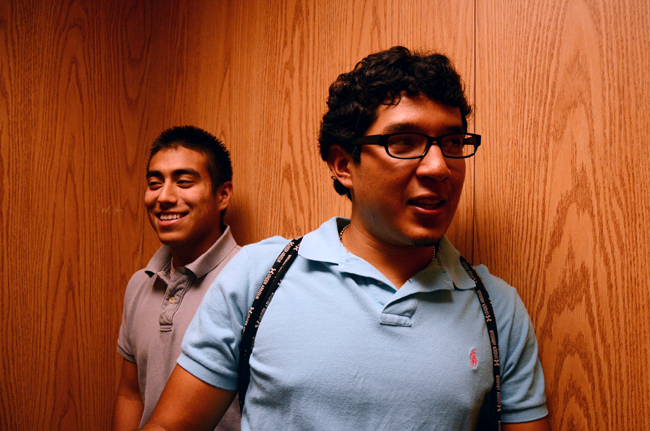Editor's note: This story is the first in a series exploring race, racism and diversity on the UT campus.
Two UT students aim to challenge common conceptions about young Latino men in college during their time on the 40 Acres. Manuel Ramirez, an international relations and global studies freshman, and Josh Pina, a biology freshman, are good friends who made it to UT in very different ways.
The Latino population of the U.S. is estimated at 50.5 million, about 16.3 percent of the population, according to the U.S. Census Bureau.
The percentage of Latinos enrolled at UT has steadily risen during the last four years. Latinos currently make up 17.6 percent of student enrollment, but social expectations, negative influences in low status neighborhoods and low access to high-caliber education pose challenges that prevent them from enrolling in higher education institutions.
Ramirez was born in Guanajuato, Mexico. When Ramirez was 9-years-old, his parents crossed the Rio Grande into the U.S. to work as migrant field workers picking strawberries in Texas, Tennessee and Florida. His family settled in the rural town of Florence, Texas where they did yard work for their neighbors.
Ramirez said his family was one of the five Latino families that didn’t speak English in a town with a population of about 1,000 at the time.
Pina is a third-generation Mexican-American, but he said he didn’t grow up practicing his grandparents’ Mexican customs. He grew up in the east side of Amarillo where communities consist of Latino and black neighborhoods of lower socioeconomic status. When he attended magnet programs in middle and high school on the west side of town, where the population is predominantly white, he felt like part of a minority group in school for the first time even though he did not speak Spanish.
“It was difficult to get used to the environment at first, and I had to face the stereotype my peers had of me,” Pina said. “I also had to prove that I was more than the low expectations some of my teachers had of me.”
Pina said he benefited from the education he received at the schools of higher caliber that he attended because of the standard of education and college preparation they provided. He began his first year at the University with various scholarships and credit hours he obtained through dual-enrollment classes.
During Ramirez’s junior year in high school, his counselor told him he couldn’t enroll in dual credit enrollment classes his school offered because of his undocumented status.
His counselor was unaware of House Bill 1403, a state law that allows undocumented students to attend college if they graduated from a Texas high school and resided in the state for at least three years before graduation. Ramirez said he felt defeated when his former girlfriend and her family suggested they get married in order to grant him citizenship.
Eventually, it was her family that helped him find University Leadership Initiative, an undocumented student activist group at UT that guided him through the process of enrolling in college.
Ramirez graduated third in his high school class and is one of the 600 undocumented students that ULI estimates are enrolled at UT.
“College is such a natural thing for others. It’s the next step,” he said. “It all happened so fast, and it still hasn’t hit me that I am here because I don’t know what I’m supposed to feel like.”
Pina and Ramirez both said one of the biggest challenges they faced was not having academic role models in the their communities to look up to while growing up, but they both dreamed of going to college. Today, they have become role models for others.
Pina’s parents didn’t make it to their high school graduations, as both dropped out to help their own parents make ends meet.
He considers himself a role model for his four younger siblings and for his parents. His father, Danny Pina, is following in his son’s pursuit and currently attends Amarillo College.
“My wife and I missed out on a lot of things for lack of money and encouragement,” Danny Pina said. “We didn’t have someone pushing us to be better.”
Ramirez’s younger sister Maria, who is graduating from Florence High School this year, will be attending UT in the fall.
“Our whole lives we have been limited to what we can do based on what others tell us we can and can’t do,” she said. “My brother found the motivation to prove to the people that told him he couldn’t go to college wrong.”
Ramirez said his journey is one that Latino students can follow to surpass the expectations their communities impose on them.
“You grow up with cultural and social expectations that are imposed on you by your community and eventually start believing them,” he said. “I didn’t want to be a statistic. I just wanted to go to college, and here I am.”
Printed on Wednesday, April 25, 2012 as: Latino Students succeed in face of odds





















